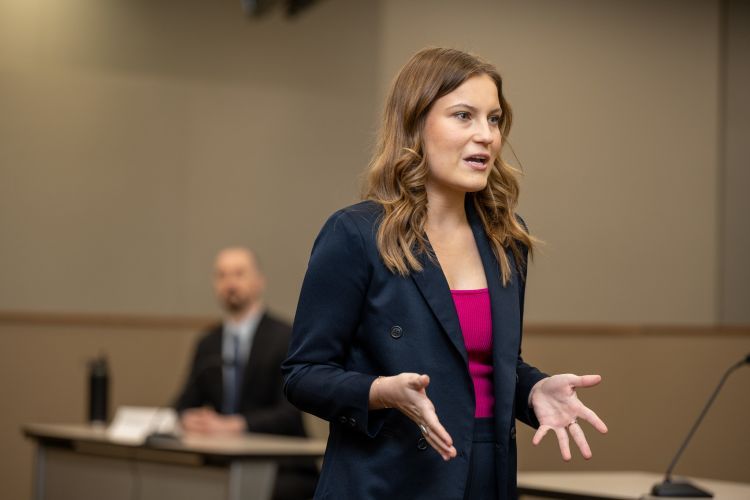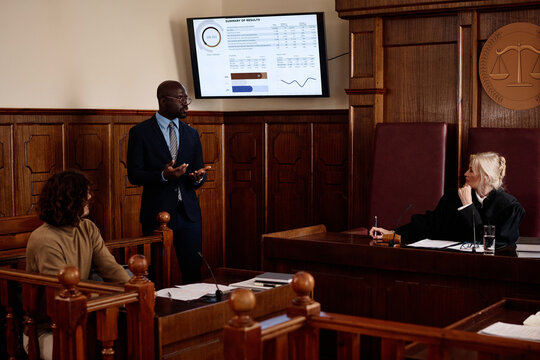Essential Skills for Crafting Persuasive Trial Presentations: A Comprehensive Guide
Essential Skills for Crafting Persuasive Trial Presentations: A Comprehensive Guide
Blog Article
Navigating the Intricacies of Trial Presentations: Tips for Seamless Distribution and Compelling Disagreements
In the world of legal proceedings, the art of test presentation stands as an essential factor of success. As lawyers navigate the intricate web of courtroom dynamics, the capacity to perfectly supply disagreements and proof while mesmerizing the court's attention comes to be critical. The intricacies inherent in test discussions require a fragile balance of ability, skill, and strategy. By developing strategies that ensure a refined shipment and crafting engaging arguments that resonate with the target market, attorneys can considerably boost their campaigning for. In a world where persuasion reigns supreme, grasping the details of trial presentations is not simply an alternative but a necessity for those seeking to prevail in the court room.

Understanding Trial Goals
To properly browse a trial, it is vital to have a clear understanding of the purposes that need to be accomplished. Prior to entering the court, lawful teams have to define their goals and desired results. These goals act as assisting concepts throughout the test, forming approaches and influencing decision-making processes.
Understanding trial objectives involves an extensive analysis of the situation, legal precedents, and the client's best interests. Trial Presentations. It calls for a meticulous evaluation of the truths, identifying crucial issues, and expecting possible obstacles. By establishing particular and quantifiable goals, attorneys can tailor their discussions and disagreements to line up with the preferred results
Moreover, a clear grip of test goals allows legal groups to focus on evidence, witnesses, and legal debates successfully. It permits the advancement of a coherent story that reverberates with the judge and court, reinforcing the general case discussion.

Organizing Evidence Effectively
Having a clear understanding of trial purposes lays the structure for organizing evidence properly in lawful procedures - Trial Presentations. By aligning the discussion of proof with the desired outcomes of the test, legal teams can reinforce their disagreements and enhance their persuasiveness. One crucial facet of organizing evidence is classification. Grouping proof based upon themes or importance to certain legal components can assist improve the discussion and make complicated information extra digestible for the judge or court.
One more key aspect in organizing proof efficiently is developing a logical circulation. Presenting evidence in a coherent and sequential way can help develop an engaging narrative that sustains the lawful arguments being made. In addition, using visual help such as graphs, charts, or timelines can better enhance the organization of proof and aid in clarifying complicated relationships or sequences of events.
Moreover, ensuring that all evidence provided is appropriate and acceptable to the instance is important. Inadmissible or unnecessary evidence can diminish the stamina of the debate and possibly damage the trustworthiness of the here and now event. For that reason, a precise evaluation and option procedure need to be undertaken to include only the most impactful and legitimately audio proof in the test discussion.
Crafting Convincing Narratives
Crafting engaging narratives plays an essential role in offering influential debates during legal proceedings. A well-crafted narrative has the power to mesmerize the audience, evoke emotions, and eventually persuade the decision in favor of the providing my link celebration. When building a story for a trial presentation, it is necessary to develop a clear storyline that highlights bottom lines and connects them in a meaningful way. Begin by describing the truths of the case in a compelling manner, ensuring that the series of occasions is very easy to comply with. Introduce personalities successfully, supplying background information that helps the target market recognize their actions and inspirations. Furthermore, integrating vivid summaries and interesting language can bring the narrative to life, making it more remarkable for the discretionary. By weaving together proof, statement, and legal debates into a convincing and cohesive story, lawyers can properly promote for their clients and raise the probability of a beneficial end result in the court.
Mastering Visual Help
Effective use aesthetic help is key to Discover More improving the influence and clarity of trial presentations. Visual aids, when made use of strategically, have the power to simplify intricate details, reinforce bottom lines, and leave a long lasting perception on the court and court. To master visual help in test discussions, it is essential to make sure that they are clear, succinct, and pertinent to the arguments being made.
When incorporating visual help, such as graphes, timelines, photographs, or graphs, right into a trial presentation, it is necessary to maintain them aesthetically appealing yet expert. The visuals need to enhance the spoken debates, giving a visual depiction of the details being reviewed without frustrating the target market with unneeded information.
In addition, exercising with the aesthetic help ahead of time is crucial to make certain a smooth shipment throughout the trial. Familiarizing oneself with the content, transitions, and timings of each visual aid can help keep the flow of the discussion and prevent technological problems that might occur.
Providing Impactful Closing Arguments
An engaging closing disagreement works as the culmination of a trial discussion, encapsulating the core narrative and persuading the court and jury towards a favorable choice. To provide an impactful closing argument, it is crucial to succinctly summarize bottom lines, highlight the toughness of your situation, and deal with any weak points in a tactical fashion. Begin by laying out the major arguments that sustain your client's placement, highlighting why the evidence offered throughout discover this info here the test supports your narrative. It is necessary to create a sense of communication and quality, directing the discretionary towards the wanted conclusion.
Furthermore, integrating psychological charm can better reinforce your closing argument. Ultimately, a well-crafted closing argument ought to leave an enduring perception, engaging the court and court to rule in your customer's support.
Verdict
Finally, understanding test discussions entails understanding objectives, organizing evidence, crafting narratives, utilizing aesthetic help, and delivering impactful closing debates. By applying these strategies effectively, lawyers can present their case seamlessly and make engaging debates in the court. It is vital to browse the complexities of trial discussions with accuracy and ability to accomplish success in legal proceedings.
By aligning the presentation of proof with the wanted results of the trial, lawful groups can strengthen their arguments and boost their persuasiveness (Trial Presentations). To grasp visual help in test presentations, it is essential to ensure that they are clear, succinct, and appropriate to the arguments being made
An engaging closing debate serves as the culmination of a test presentation, encapsulating the core story and convincing the judge and court towards a desirable choice. Begin by describing the main disagreements that support your customer's setting, emphasizing why the evidence offered throughout the trial sustains your story.In conclusion, understanding trial discussions includes understanding purposes, organizing proof, crafting narratives, making use of visual help, and providing impactful closing debates.
Report this page